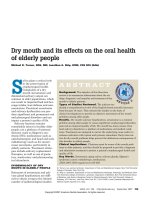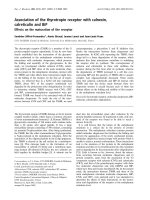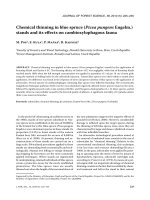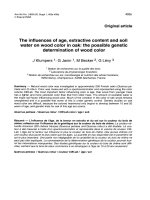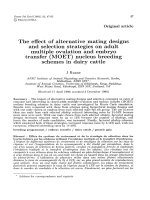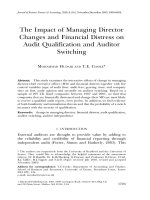The use of subtitled english movies and its effects on EFL high school students’ speaking ability
Bạn đang xem bản rút gọn của tài liệu. Xem và tải ngay bản đầy đủ của tài liệu tại đây (1.72 MB, 113 trang )
MINISTRY OF EDUCATION AND TRAINING
VINH UNIVERSITY
TRINH THI LOAN
THE USE OF SUBTITLED ENGLISH MOVIES AND ITS EFFECTS ON
EFL HIGH SCHOOL STUDENTS’ SPEAKING ABILITY
MASTER’S THESIS IN EDUCATION
Nghệ An, 2017
MINISTRY OF EDUCATION AND TRAINING
VINH UNIVERSITY
TRINH THI LOAN
THE USE OF SUBTITLED ENGLISH MOVIES AND ITS EFFECTS ON
EFL HIGH SCHOOL STUDENTS’ SPEAKING ABILITY
Major: Teaching English to Speakers of Other Languages (TESOL)
Code: 60.14.01.11
MASTER’S THESIS IN EDUCATION
Supervisor: Dr. Tran Thi Ngoc Yen
Nghệ An, 2017
STATEMENT OF AUTHORSHIP
I certify that the thesis entitled “The use of subtitled English movies and its effects
on EFL high school students’ speaking ability” is the result of my own work. The
data and findings discussed in the thesis are true, used with permission, and have
not been submitted to any university or institution.
Vinh, August 2017
Author’s signature
Trinh Thi Loan
i
ABSTRACT
The main goal in this study is to find out if there is any effect on EFL
learners’ speaking competence through the use of English subtitled movies.
In order to achieve the mentioned goal, the study was carried out among 30
students at Thieu Hoa high school. The participants did a general English test and
30 students were divided into two groups: control group and treatment group. Both
groups were asked to complete a pre-test before exposed to English subtitled
movies and a post-test after taking part in the treatment sessions which aimed to see
how many correct words per minute can they speak. The data were mainly collected
through sixteen lesson plans for both groups. Their speaking competence was
assessed and their achievements were recorded. Three comparisons were made: the
comparison between the average total score of eight sessions for both groups, the
comparison between the average total score of the last session and the average total
score of the first session and the comparison between the average of the pre-test and
the average of the post -test in term of means and standard deviations.
The research findings indicated that the students’ speaking fluency and
accuracy are expectation of the course. In addition, the results from the study also
revealed the improvements of the application of English subtitled movies. From
detailed findings, some implications for teaching speaking skill were proposed.
Limitations of the study were pointed out and further research was suggested.
ii
ACKNOWLEDGEMENTS
First of all, I would like to express my deep gratitude to Dr. Tran Thi Ngoc
Yen, who directly supported and encouraged me during the preparation of this
study. I am truly grateful to her for her professional advice, invaluable support and
guidance she offered to help me carry out the study.
I am also grateful to my colleagues and students of the two classes at Thieu
Hoa high school who helped me to gather data for my study.
I would also like to thank my friends for their friendship and proofreading in
the preparation of my thesis.
Last but not least, I owe special heartfelt appreciation to my family. Without
whose unceasing support, patience and understanding, I could not have been able
to complete my study.
iii
TABLE OF CONTENTS
STATEMENT OF AUTHORSHIP.............................................................................. i
ACKNOWLEDGEMENTS ....................................................................................... ii
ABSTRACT ............................................................................................................... ii
CHAPTER 1
INTRODUCTION .............................................................1
1.1 Rationale………….. .............................................................................................1
1.2 Aims of the study ..................................................................................................2
1.3 Research questions ................................................................................................3
1.4 Scope of the study .................................................................................................3
1.5 Method of the study ..............................................................................................3
1.6 Organization of the thesis ......................................................................................3
CHAPTER 2
THEORETICAL BACKGROUND ......................................4
2.1 The speaking skill..................................................................................................4
2.1.1 Nature of speaking .............................................................................................4
2.1.2 Speaking in foreign language learning...............................................................5
2.1.3 Assessing speaking ability..................................................................................8
2.2.1 Indicators of speaking ability ...........................................................................10
2.2.2 Fluency, accuracy and complexity ................................................................... 11
2.2.3 Methods to assess speaking ability ..................................................................13
2.3 Teaching the speaking skill .................................................................................16
2.3.1 Factors affecting EFL learners’ speaking ability..............................................16
2.3.2 Difficulties EFL learners have when learning speaking ..................................18
2.3.3 Principles for teaching EFL speaking ..............................................................19
2.3.4 Techniques for teaching EFL speaking ............................................................21
2.4 Multimedia and second language acquisition .....................................................23
2.4.1 Theories about multimedia ...............................................................................23
2.4.2 Influence of multimedia on second language acquisition ................................25
2.4.3 Krashen’s Input Hypothesis .............................................................................27
2.4.4 Correlation between input and output ..............................................................29
iv
2.5 Subtitled English movies.....................................................................................32
2.5.1 Definition .........................................................................................................32
2.5.3 The importance of using subtitled English movies ..........................................33
2.5.4 Principles for choosing subtitled English movies ............................................37
2.5.5 The use of subtitled English movies in language teaching ..............................41
CHAPTER 3
RESEARCH METHODOLOGY ....................................48
3.1 Research questions ..............................................................................................48
3.2 Participants ..........................................................................................................48
3.2.1 The Control Group ..........................................................................................48
3.2.2 The experimental Group ..................................................................................49
3.3 Instruments ..........................................................................................................50
3.3.1 General English test .........................................................................................52
3.3.2 Pre-test and post-test ........................................................................................53
3.4 Procedure.............................................................................................................53
CHAPTER 4
FINDINGS AND DISCUSSION………...…………….56
4.1 Results from the experiment ...............................................................................56
4.1.1 General English test .........................................................................................56
4.1.2 Pre-test results ..................................................................................................59
4.1.3 Post-test results.................................................................................................62
4.1.4 The improvement that the two groups made ....................................................64
4.1.4.1 The improvement of fluency that the two groups made ...............................64
4.1.4.2 The improvement of accuracy that the two groups made .............................64
4.2. Discussion of the main findings .........................................................................73
CHAPTER 5
CONCLUSION ................................................................78
5.1 Conclusion...........................................................................................................78
5.2 Implications of the Study ....................................................................................79
5.3 Limitations ..........................................................................................................80
5.4 Suggestions for further research..........................................................................80
REFERENCES ........................................................................................................82
v
APPENDIX A ...........................................................................................................83
APPENDIX B ...........................................................................................................87
APPENDIX C ...........................................................................................................88
APPENDIX D ...........................................................................................................89
APPENDIX E............................................................................................................90
APPENDIX F ............................................................................................................90
APPENDIX G ...........................................................................................................90
APPENDIX H ...........................................................................................................90
vi
LISTS OF TABLES
Table 3.1: The control group’s background information...........................................49
Table 3.2: The experimental group’s background information .................................49
Table 3.3: Topics of speaking in English 12 ..............................................................50
Table 4.1 The experimental and control group’s score in general English test ........56
Table 4.2 The average total scores and standard deviations of general English test
in the experimental group and the control group ......................................................59
Table 4.3 The experimental and control group’s score in pre- test ...........................59
Table 4.4 The average total scores and standard deviations of pre- test in the
experimental group and the control group ................................................................60
Table 4.5 The experimental and control group’s score in post- test..........................62
Table 4.6 The average total scores and standard deviations of post- test in the
experimental group and the control group ................................................................63
Table 4.7The increase difference of fluency between the pre-test scores and the post
test scores by all participants (p) in both groups. .....................................................67
Table 4.8 Summary of the increase levels of all participants for both groups ..........68
Table 4.9 Means and standard deviations of speaking accuracy of the pre-test and
the post-test of both groups .......................................................................................69
vii
LISTS OF FIGURES
Figure1. Simplified version of Grass’s model of IIO, applied to multimedia .... Error!
Bookmark not defined.
Figure 4.1a: The general test scores of the control group ........................................57
Figure 4.1b: The general test scores of the experimental group ..............................58
Figure 4.2a: The pre- test scores of the control group ..............................................60
Figure 4.2b: The pre- test scores of the experimental group ....................................61
Figure 4.3a: The post test scores of the control group .............................................64
Figure 4.3b: The post test scores of the experimental group ....................................65
Figure 4.4. The pre-test and the post test mean's score of fluency for both groups ..66
Figure 4.5 The pre-test and post-test mean’s score of accuracy for both groups. ....70
Figure 4. 6: Control group’s score type distribution .................................................71
Figure 4.7: Experimental group’s score type distribution ........................................72
viii
CHAPTER 1
INTRODUCTION
This chapter is written with the purpose of giving the rationale, objectives of
the study, the research questions, the scope of the study, an overview of research
methodology and finally introduces the outline of the thesis.
1.1
Rationale
English as a language of international communication and lingua franca,
people considerably think to learn English, which is used and spoken worldwide
for education, business, communication, and others. With regard to the
importance of English as Foreign language (EFL), the teaching of EFL speaking
has been deemed important in the Vietnamese context. In general, Richards and
Renandya (2002:201) point out that a large number of language learners study
English in order to develop proficiency in speaking. In short a word, speaking is
usually considered as the core skill in foreign language learning.
Regarding some factors that really influence the quality of the speaking
skill, Shumin (2002:204) emphasizes that when people learn to speak a foreign
language, they require more than knowing its grammatical and semantic rules,
and learners need to acquire the knowledge of how native speakers use the
language in context. In short, understanding those factors really facilitate EFL
learners’ awareness of the speaking skill and improve its quality.
As a common problem was occurred in a speaking class is that teachers
frequently feel it difficult to involve students in the speaking activities. In fact,
English teachers should work hard to attract the students to speak a lot in the class.
It occurs because many EFL learners face some problems in learning speaking;
many English learners are reluctant and unmotivated (Nunan, 1999), the students
are reluctant, fearful of making mistakes, or lack of adequate vocabulary (Fauzan,
2014).These problems are still frequently experienced by teachers and become a
challenge for them in teaching speaking in the class.
In the practices of the teaching of EFL speaking in Vietnam, both English
teachers and students still have been encountering many problems. Based on
1
some research, there have been at least four main issues that some researchers
and teachers often investigate. Widiati and Cahyono (2006:277) report that the
teaching of EFL speaking for secondary- level students deal with teaching
problems, classroom activities, teaching materials, and assessment. These things
are related to the improvement of the teaching quality of EFL speaking that
would point out obvious picture of the teachers’ position and what they are
necessary to do.
As stated above the importance, the factors, and the problems of the
speaking skill discussed above, subtitled English movies play good impact on
developing speaking ability as Kelly’s (1985) idea that the subtitled English
movies have obviously given the contribution to language learning in many ways.
In other words, the movie is potentially fruitful to provide fun and interesting
learning experience to encourage the student s’ motivation, self confidence, and
of course improve their speaking skill, in terms of their grammar, vocabulary,
fluency and pronunciation. Moreover, it also would offer the students a
comprehensible input of English that helped them to recognize how the target
language is used, and uttered in the real context.
For the above-mentioned reasons the researcher has decided to conduct the
study entitled “The use of subtitled English movies and its effects on EFL high
school students’ speaking ability” at her work place- Thieu Hoa high school. There
are two benefits expected from this study. Theoretically, it gives out useful
references for further research on using subtitled English movies to develop high
school students’ speaking skills. Practically, the result of this research will suggest
new directions for exploiting the effects of subtitled English movies to improve the
quality of teaching English, especially the quality of teaching speaking skill.
1.2 Aims of the study
This study aimed to examine the effect of subtitled English movies on EFL
high school student’s speaking competence. The writer mainly assess two aspects of
speaking, they are speaking fluency and speaking accuracy.
2
1.3 Research questions
The study was set to answer the following research questions:
- How do subtitled English movies affect EFL learners’ speaking accuracy?
- How do subtitled English movies affect EFL learners’ speaking fluency?
1.4 Scope of the study
There are many strategies to improve speaking skill for EFL learners, and
using subtitled English movies is one of the most effective strategies. This study
was set to investigate the effects of subtitled English movies on helping students to
developing their speaking skill. Only two aspects were examined: accuracy and
fluency.
1.5 Method of the study
The method employed in this study is experimental. All comments, remarks,
recommendations and conclusion were based on the data analysis. The combination
of different instruments used in this research helped to gain reliable data, thus the
researcher had a close investigation into how subtitled English movies affect on
students’ speaking competence.
1.6 Organization of the thesis
The thesis consists of five chapters. Chapter I, The Introduction, includes
rationale for the study, the aims, methods, scope, and design of the study. Chapter II
comes the second, in which a theoretical background was presented. Chapter III
presents the methodology of the study. Chapter IV also consists of findings and
discussion, in which the data is described and discussed. Chapter V comes last. A
conclusion of the study, the limitations of the study, and suggestion for further
research are also mentioned in the last chapter.
3
CHAPTER 2 THEORETICAL BACKGROUND
This chapter focuses on the literature review and theoretical background of
the study. It presents a brief review of the literature on the topics that are generally
related to the research in this thesis. Previous studies on the speaking skill, the
teaching speaking skill, the principles of using subtitled English movies in EFL
speaking instruction will be mentioned.
2.1 The speaking skill
Speaking skills is the ability to communicate in a new language - target
language - based on its grammatical, contextual, social, and cultural rules. There are
many factors affecting the students’ learning speaking. We can name some of major
factors: voice, accent, intonation, stress, pronunciation, speed, etc. The students
often feel difficult to have the correct stress and intonation as the native speakers.
They also feel it not easy to keep up with the speed of speech by native speakers.
The teacher at class can partly help the students solve these problems. However, in
fact, many teachers also face the same difficulties. Each language has its own
phonetic characteristics, which not many language learners can imitate. In this case,
sound and image from audio-visual materials can help much when the students
can hear the direct pronunciation and see the operation of articulator organs.
The students’ leaning speaking can be fostered by the effective sound and image
from audio-visual materials.
2.1.1 Nature of speaking
There are many definitions of speaking that have been proposed by some
experts in language learning. Speaking is one of the four language skills taught in
the teaching of English. People speak in order to express their idea, their feeling or
respond to the other’s talk. When the others can understand what has been talked,
it means that the speaker gets the meaning across. Thornbury (2005: 20) mentions
that speaking is an interactive real time activity to express meaning to interact with
others that unplanned and just continues based on situations. However, the teacher
must notice that in EFL context the students seldom try to produce their foreign
4
language because they aware about the gaps in their knowledge. A speaker requires
attention to precise details of the language. She/he needs to find the most
appropriate words and the correct grammar to convey meaning accurately and
precisely and also need to organize the discourse, so that a listener will understand.
In addition, Brown (2001) writes that when someone can speak a language it
means that he/she can carry on a conversation reasonably competently. According
to Thornbury (2005), speaking is an interactive skill that requires the ability to
have cooperation with the other aspects of language. Speaking skill needs to be
developed and practiced independently from the other aspects of language, such as
grammar and listening. In that case, the teaching and learning process will be as
interesting as possible to be conducted in each classroom in order to make the
students become more interested in learning the other aspects of language.
2.1.2 Speaking in foreign language learning
Learning and Teaching English as a foreign language requires learner‘s
interaction, production and communication to what is called the speaking skill.
The aim of producing this skill is to achieve a higher development of abilities of
receiving and producing the second language either in oral form. Speaking is
regarded as the main skill to be developed because it is necessary for displaying
the language proficiency, the importance is mainly on speaking because learners
are going to be put in situations where communication in English is needed.
2.1.2.1 Definition
There is no much difference between speaking in the first language and
speaking in the second language. Second language speakers also produce speech
through a process of conceptualizing, formulating, and then articulating, during
which there is a process of self-monitoring (Thornburry, 2005: 28).
Thornburry (2005) states that the difference is on the language itself. The
knowledge of second language speakers is not as extensive and as established as
their knowledge of the first language. Second language speakers tend to formulate
utterances in the first language and, then, translate it into the second language.
5
He also states that the pressure to be accurate – to avoid making humiliating
errors may mean that the self monitoring process is overused and over-prolonged,
again with a negative effect in terms of fluency. In order to be understood, second
language speakers apply, at least, two strategies in speaking, namely communicative
strategy and discourse strategy.
Thornburry (2005: 40) proposes the terms of the basic knowledge that enable
speech in a second language, as follows:
- A core grammar
- A core vocabulary of at least 1000 high-frequency items
- Some common discourse markers
- A core -phrase book of multi-word units (chunks)
- Formulaic ways of performing common speech acts, such as requesting or
inviting.
- Mastery of those features of pronunciation that inhibit intelligibility.
2.1.2.2 Speaking competence
Speaking competences consist of four elements. They are grammatical
competence (linguistic competence), sociolinguistic competence (pragmatic
competence), discourse competence, and strategies competence (Scarcely &
Rebecca, 1992).
Grammatical or linguistic competence enables speakers to use and
understand
grammatical
structures,
sentence
structures
accurately
and
unhesitatingly, and thus, it contributes to the speaker’s fluency (Scarcella &
Rebecca, 1992). Grammatical competence is concerned with mastery of the
linguistic code (verbal or non-verbal) which includes vocabulary knowledge as
well as knowledge of morphological, syntactic, semantic, phonetic and orthographic
rules. This competence allows the speaker to use data and abilities required for
comprehending and expressing the factual meaning of utterances (Canale & Swain,
1980, cited in Bagarić & Djigunović, 2007).
6
Sociolinguistic or pragmatic competence is generally considered to involve
two kinds of ability. First, it is the ability of knowing how to use language in order
to achieve certain communicative goals or intentions (Hedge, 2000). Second, the
ability to use language appropriate in social context. Thus, learners need to know
the appropriate social conventions. It can be seen, then, that social knowledge is
necessary to select the language forms to use in different settings, and with people
in different roles and with different status. In other words, as Hymes (1972)
explained speakers should know “when to speak, when not, what to talk about with
whom, when, where and in what manner”.
Discourse competence is the knowledge of discourse rules such as cohesive
and coherence to present then produce unified written or spoken language. As
described by Celce-Murcia (2007) that discourse competence refers to the selection,
sequencing, and arrangement of words, structures, and utterances to achieve a
unified spoken message. This is where the top-down communicative intent and
socio cultural knowledge intersect with the lexical and grammatical resources to
express messages and attitudes and to create coherent texts.
Strategic competence is collected of facts of verbal and non-verbal
communication strategies that are reminded to compensate for crashes in
communication due to deficient competence in one or more components of
communicative competence. These strategies include paraphrasing, circumlocution,
repetition, reluctance, avoidance of words, structures or themes, guessing, changes
of register and style, modifications of messages etc( Celce- Murcia, 2007).
Strategic competence consists of using communication strategies which
come into play when the learners are unable to express what they want to say
because they lack the recourses to do so successfully. They compensate for this
either by changing their original intention or by searching for other means of
expression.
The learners can use achievement strategies to explain what they are trying
to say and find the ways of compensating for their insecure or inadequate
7
knowledge of English; as a result, they keep the conversation going and may
encourage the listener to provide the necessary language.
Moreover, learners can use reduction strategies to avoid the forms of which
they are uncertain and select the perhaps structure which they know. The question
arising is whether strategic competence can be trained. Certainly teachers can help
students early in a language program by teaching them appropriate questions for
requesting help (eg: what does it mean? How do you say?), and the language to ask
for vocabulary items (eg: what do you call the person who? What do you call the
thing that?). The teacher can also act as listener in classroom interaction and
respond to students’ appeals for help, providing language at the point of need
2.1.3 Assessing speaking ability
According to Porter and Roberts in O’Malley (1996), assessment of oral
language should focus on a student’s ability to interpret and convey meaning for
authentic purposes in interactive contexts. It should include both fluency and
accuracy. Cooperative learning activities that present students with opportunities to
use oral language to interact with others whether for social or academic purposes
are optimal for assessing oral language.
Brown and Yule (1983:120) state that the oral component of English
language assessment may be based on a very general impression of how well
students speak. This normally takes the form of an oral interview in which the
examiner asks students questions, or prompts students to talk on certain, sometimes
pre-arranged topics.
Furthermore, every opportunity for speaking in the classroom should be
taken. It is by asking students to do communication that realizes their need of
language and doing conversation with them to increase their fluency and
confidence. For example, students may be reluctant to speak in front of many
people. However, there are ways of providing a safer, less public environment in
which they can begin to practice speaking. The ways are by repetition work and pair
work activities. Besides, teachers also pay attention to aspects such as accuracy and
8
fluency in students' speech. According to Gower et al. (1995: 99), the accuracy
involves the correct use of the vocabulary, grammar and pronunciation. In
controlling and guiding activities, teachers usually focus on the accuracy and it is
important for teachers to give feedback to students. Fluency can be defined as an
ability to keep going when students speak spontaneously. When students speak
fluently, they should be able to get the message across with whatever resources and
the abilities they have got regardless grammatical structures and other mistakes.
Moreover, Thornbury (2005) states that there are two ways to assess
students’ speaking ability. The first is known as a holistic scoring. In the holistic
scoring, the teacher only gives a single score on the basis on an overall impression.
This holistic way has advantages of being quick and is perhaps suitable for informal
testing of progress. Then, the second way is through an analytic scoring which gives
separate scores for different aspects of the task. This scoring takes longer, but
requires the teacher to take the variety of factors into account and it is probably
fairer and more reliable. However, one disadvantage is that the score may be
distracted by all categories and lose sight of the overall situation performed by the
students. Therefore, four or five categories are probably to be the maximum criteria.
Meanwhile, Blaz (2000) argues that speaking is a complex skill requiring
the simultaneous use of different ability which often develops at different rates. She
states that there are five components that are generally recognized in analyses of the
speech process. They are pronunciation, task completion, vocabulary, fluency, and
comprehensibility. Each element characteristics are then defined into four short
indicators. This helps to make the test reliable, since it avoids subjectivity because it
provides clear, precise and mutually exclusive indicator statements for each point of
the scale.
Regarding the way in assessing the students’ speaking ability proposed by
Thornbury (2005) and Blaz (2000), the researcher proposes to incorporate the
analytic scoring with the rating scale. By combining the analytic scoring and rating
9
scale techniques, the process of assessing the students’ speaking ability will be
more precise and easier.
2.2.1 Indicators of speaking ability
The following are indicators stated by Brown (2000: 271-274) indicating that
one can be called having a speaking ability. They are as follows:
- Imitative. He/she is able to imitate a word or phrase or possibly a sentence.
- Intensive. He/she is able to produce short stretches of oral language designed to
demonstrate ability in a narrow band of grammatical, phrasal, lexical, or
phonological relationship (such as prosodic elements – intonation, stress, rhythm,
juncture).
- Responsive. He/she is able to respond a very short conversation, standard
greetings and small talk, simple requests and comments.
- Transactional (dialogue). He/she is able to take the two forms of either
transactional language which has the purpose of exchanging specific information
- Interpersonal. It has the purpose of maintaining social relationships with the
transmission of facts and information.
- Extensive (monologue). He/she is able to develop (monologue) oral production
including speeches, oral presentation, and story telling, during which the
opportunity for oral interaction from listeners is either highly limited or ruled out
together.
Meanwhile, Ur (1999: 120) says that the characteristics of a successful
speaking activity are as follows:
First, learners talk a lot. As much as possible of the period of time allotted to
the activity is in fact occupied by learners’ talk. This may seem obvious, but often
most time is taken up with teacher talk or pauses.
Second, participation is even. Classroom discussion is not determined by a
minority of talkative participants; all get chance to speak, and contributions are
fairly evenly distributed.
10
Third, motivation is high, learners are eager to speak; because they are
interested in the topic and have something new to say about it or because they want
to contribute to achieving a task objective.
Last, language is of an acceptable level. Learners express themselves in
utterances that are relevant, easily comprehensible to each other, and of an
acceptable level of language accuracy.
From the statement above, it can be concluded that someone owns a certain
language speaking competence if he/she can produce oral language to participate in
any kind of activity. He/she can also respond the other ones’ speaking to maintain
his/her social relationship. Besides, his/her language is acceptable and easily
comprehensible at the level of language accuracy.
2.2.2 Fluency, accuracy and complexity
Many researchers and language practitioners believe that the constructs of
second language performance and second language proficiency are multicomponential in nature and that their principle dimensions can be adequately,
comprehensively and captured by the notions of complexity, accuracy and fluency
(Shehan 1998).
Accuracy (or correctness) is probably the oldest, most transparent and most
consistent construct of the triad, referring to the degree of deviancy from a
particular norm (Hammerly 1991; Wolfe-Quintero et al. 1998). Deviations from the
norm
are
usually
characterized
as
errors.
Straightforward
though
this
characterization may seem, it raises the thorny issue of criteria for evaluating
accuracy and identifying errors, including whether these criteria should be tuned to
prescriptive standard norms (as embodied by an ideal native speaker of the target
language) or to non-standard and even nonnative usages acceptable in some social
contexts or in some communities (Ellis 2008; James 1998; Polio 1997). There is not
the same amount of (relative) denotative congruence in the applied linguistics
community with regard to fluency and complexity as there is with regard to
accuracy.
11
Historically, and in lay usage, fluency typically refers to a person's general
language proficiency, particularly as characterized by perceptions of ease,
eloquence and ‘smoothness’ of speech or writing (Chambers 1997; Freed 2000).
Language researchers for their part have mainly analyzed oral production data to
determine exactly which quantifiable linguistic phenomena contribute to fluency in
L2 speech (e.g. Lennon 1990; Kormos and Dénes 2004). This research suggests that
speech fluency is a multi-componential construct in which different sub-dimensions
can be distinguished, such as speed fluency (rate and density of delivery),
breakdown fluency (number, length and distribution of pauses in speech) and repair
fluency (number of false starts and repetitions) (Tavakoli and Skehan 2005).
As befits the term, complexity is the most complex, ambiguous and least
understood dimension of the CAF triad. For a start, the term is used in the SLA
literature to refer both to properties of language task (task complexity) and to
properties of L2 performance and proficiency (L2 complexity) (e.g., Robinson
2001; Skehan 2001). L2 complexity in turn has been interpreted in at least two
different ways: as cognitive complexity and as linguistic complexity (DeKeyser
2008; Williams and Evans 1998). Both types of complexity in essence refer to
properties of language features (items, patterns, structures, rules) or (sub) systems
(phonological, morphological, syntactic, lexical) thereof. However, whereas
cognitive complexity is defined from the perspective of the L2 learner-user,
linguistic complexity is defined from the perspective of the L2 system or the L2
features. Cognitive complexity (or 4 difficulties) refers to the relative difficulty with
which language features are processed in L2 performance and acquisition. The
cognitive complexity of an L2 feature is a variable property which is determined
both by subjective, learner-dependent factors (e.g. aptitude, memory span,
motivation, L1 background) as well as by more objective factors, such as its input
saliency or its inherent linguistic complexity. Thus, cognitive complexity is a
broader notion than linguistic complexity, which is one of the (many) factors that
may (but need not) contribute to learning or processing difficulty.
12
Another point of discussion concerns the question to what extent these three
dimensions are in(ter)dependent in L2 performance and L2 development (Ellis
1994, 2008; Skehan 1998). For instance, according to Ellis, increase in fluency in
L2 acquisition may occur at the expense of development of accuracy and
complexity due to the differential development of knowledge analysis and
knowledge automatization in L2 acquisition and the ways in which different forms
of implicit and explicit knowledge influence the acquisition process. The
differential evolution of fluency, accuracy and complexity would furthermore be
caused by the fact that ‘the psycholinguistic processes involved in using L2
knowledge are distinct from acquiring new knowledge. To acquire the learner must
attend consciously to the input and, perhaps also, make efforts to monitor output,
but doing so may interfere with fluent reception and production’ (Ellis 1994: 107).
Researchers who subscribe to the view that the human attention mechanism and
processing capacity are limited (e.g. Bygate 1999; Skehan 1998; Skehan and Foster
1999) also see fluency as an aspect of L2 production which competes for attention
resources with accuracy, while accuracy in turn competes with complexity.
Learners may focus (consciously or subconsciously) on one of the three dimensions
to the detriment of the other two. A different view is proposed by Robinson (2001,
2003) who claims that learners can simultaneously access multiple and noncompetitional attention pools; as a result manipulating task complexity by
increasing the cognitive demands of a task can lead to simultaneous improvement of
complexity and accuracy.
2.2.3 Methods to assess speaking ability
Regarding to assessing speaking ability, the teachers should give out
objective grades in speaking class, and they can use the following criteria for
evaluating students’ speaking abilities.
First is to create a rubric. Most teachers will be familiar with the concept of
grading with a rubric, a table with different criteria and a grading scale. The
columns in the table will represent potential skill levels of the students. For each
13
criterion, define what level of the ability a student at each of the levels would
exhibit. Take the average level among the criteria and we have an objective grade
with suggestions for areas in which our students can improve.
Second criterion is based on pronunciation. Pronunciation is a basis quality
of language learning. Though most second language learners will never have the
pronunciation of a native speaker, poor pronunciation can obscure communication
and prevent an ESL student from making his meaning known. When evaluating the
pronunciation of our students, listen for clearly articulated words, appropriate
pronunciations of unusual spellings, and assimilation and contractions in suitable
places. Also, listen for intonation. Are students using the correct inflection for the
types of sentences they are saying? Do they know that the inflection of a question is
different from that of a statement? Listen for these pronunciation skills and
determine into which level the students fall.
Vocabulary should also be taken into consideration. After noting students’
pronunciation levels, move to vocabulary. Vocabulary comprehension and
vocabulary production are always two separate banks of words in the mind of a
speaker, native as well as second language. We should encourage students to have a
large production vocabulary and a larger recognition vocabulary. For this reason it
is helpful to evaluate our students on the level of vocabulary they are able to
produce. Are they using the specific vocabulary we have instructed them in the
semester? Are they using vocabulary appropriate to the contexts in which they are
speaking? Listen for the level of vocabulary our students are able too produce
without prompting and then decide how well they are performing in this area.
The next criterion relates to accuracy. Grammar has always been and forever
will be an important issue in foreign language study. Writing sentences correctly on
a test, though, is not the same as accurate spoken grammar. As students speak, listen
for the grammatical structures and tools we have taught them. Are they able to use
multiple tenses? Do they have agreement? Is word order correct in the sentence? All
14
these and more are important grammatical issues, and an effective speaker will
successfully include them in his or her language.
A student may also struggle with grammar and pronunciation, but how
creative is she when communicating with the language she knows? Assessing
communication in our students means looking at their creative use of the language
they do know to make their points understood. A student with a low level of
vocabulary and grammar may have excellent communication skills if she is able to
make you understand her, whereas an advanced student who is tied to manufactured
dialogues may not be able to be expressive with language and would therefore have
low communication skills. Don’t let a lack of language skill keep your students
from expressing themselves.
Being able to say what you mean with a foreign language is one thing, being
able to interact with others is another. Ask your students questions. Observe how
they speak to one another. Are they able to understand and answer questions? Can
they answer you when you ask them questions? Do they give appropriate responses
in a conversation? All these are elements of interaction and are necessary for clear
and effective communication in English. A student with effective interaction skills
will be able to answer questions and follow along with a conversation happening
around him. Great oratory skills will not get anyone very far if he or she cannot
listen to other people and respond appropriately. Encourage our students to listen as
they speak and have appropriate responses to others in the conversation.
Fluency may be the easiest quality to judge in our students’ speaking. How
comfortable are they when they speak? How easily do the words come out? Are
there great pauses and gaps in the student’s speaking? If there are then your student
is struggling with fluency. Fluency does not improve at the same rate as other
language skills. You can have excellent grammar and still fail to be fluent. You
want your students to be at ease when they speak to you or other English speakers.
Fluency is a judgment of this ease of communication and is an important criterion
when evaluating speaking.
15

